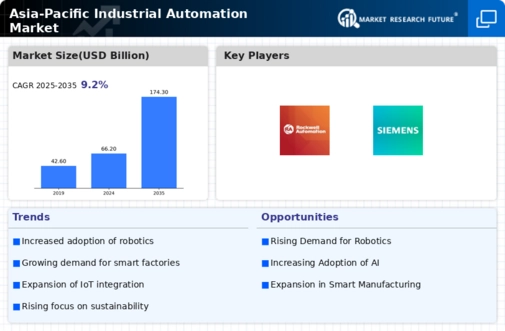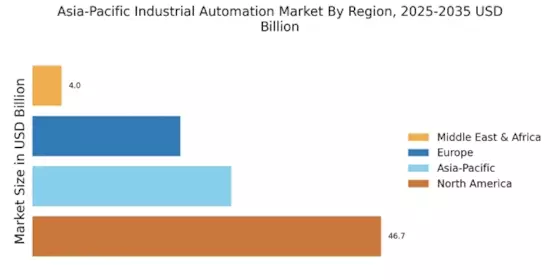Rising Demand for Efficiency
The Asia-Pacific Industrial Automation Market experiences a notable surge in demand for enhanced operational efficiency. Industries are increasingly adopting automation technologies to streamline processes, reduce labor costs, and minimize human error. This trend is particularly evident in manufacturing sectors, where automation can lead to significant productivity gains. According to recent data, companies that implement automation solutions can achieve efficiency improvements of up to 30%. As competition intensifies, businesses are compelled to invest in automation to maintain their market position. This drive towards efficiency not only enhances profitability but also supports the overall growth of the Asia-Pacific Industrial Automation Market, as more organizations recognize the value of automated systems in achieving their operational goals.
Government Initiatives and Support
Government initiatives play a pivotal role in shaping the Asia-Pacific Industrial Automation Market. Many countries in the region are implementing policies that promote the adoption of automation technologies. These initiatives often include financial incentives, grants, and tax benefits aimed at encouraging businesses to invest in automation. For example, several governments have launched programs to support small and medium-sized enterprises in their automation journeys. This support not only facilitates the transition to automated systems but also stimulates economic growth within the region. As a result, the Asia-Pacific Industrial Automation Market is likely to benefit from increased investments driven by favorable government policies and initiatives.
Growing Focus on Safety and Compliance
The emphasis on safety and compliance is becoming increasingly critical within the Asia-Pacific Industrial Automation Market. As industries face stringent regulations regarding workplace safety and environmental standards, automation technologies are being adopted to ensure compliance. Automated systems can monitor processes in real-time, detect anomalies, and implement safety protocols without human intervention. This capability is particularly valuable in sectors such as chemicals and pharmaceuticals, where compliance is paramount. The market data indicates that companies investing in automation for safety compliance can reduce incident rates by up to 40%. Thus, the growing focus on safety and compliance is driving the expansion of the Asia-Pacific Industrial Automation Market as businesses prioritize risk management.
Technological Advancements in Automation
The Asia-Pacific Industrial Automation Market is significantly influenced by rapid technological advancements. Innovations in artificial intelligence, machine learning, and robotics are transforming traditional automation processes. These technologies enable smarter decision-making, predictive maintenance, and real-time data analysis, which are crucial for optimizing production lines. For instance, the integration of AI in automation systems can lead to a reduction in downtime by up to 20%. As these technologies evolve, they create new opportunities for businesses to enhance their operational capabilities. Consequently, the Asia-Pacific Industrial Automation Market is poised for growth as companies seek to leverage these advancements to improve their competitive edge and operational efficiency.
Increased Investment in Smart Manufacturing
The shift towards smart manufacturing is a significant driver of the Asia-Pacific Industrial Automation Market. Companies are increasingly investing in smart technologies that integrate automation with data analytics and IoT. This convergence allows for more agile and responsive manufacturing processes, enabling businesses to adapt quickly to market demands. Recent statistics suggest that the smart manufacturing sector is expected to grow at a compound annual growth rate of over 15% in the coming years. As organizations recognize the benefits of smart manufacturing, including improved quality control and reduced operational costs, the Asia-Pacific Industrial Automation Market is likely to witness substantial growth fueled by these investments.

















Leave a Comment